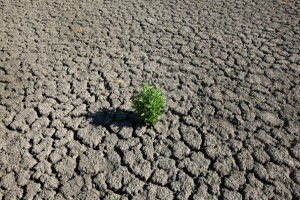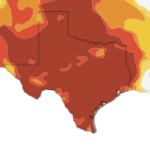How Climate Change Exacerbated the Drought

Photo by Scott Olson/Getty Images
A weed grows out of the dry cracked bed of O.C. Fisher Lake in July 2011.
Last year, Texas suffered the worst single-year drought on record. It resulted in nearly $10 billion dollars in losses to crops, livestock and timber in Texas, according to the National Oceanic and Atmospheric Administration (NOAA).
In a new report from NOAA, “State of The Climate,” the agency suggests that thanks to climate change, Texas is likely to see more extreme heat waves and dry spells like it did last year. Twenty times more likely, in fact.
Computer simulations from scientists in Oregon and England show heat waves and other weather patterns related to the La Niña weather pattern(which results in hotter, drier weather in Texas) as 20 times more likely to occur today than 50 years ago. “We found that extreme heat events were roughly 20 times more likely in 2008 than in other La Niña years in the 1960s and indications of an increase in frequency of low seasonal precipitation totals,” a paper within the report notes. The conditions behind the drought are “distinctly more probable than they were 40–50 years ago,” it says.
While the research doesn’t blame climate change as the sole cause of the extreme drought, it explains how the odds of such events occurring have increased because of global warming. Victor Murphy, a meterologist with the National Weather Service in Fort Worth tells the Houston Chronicle that warm and dry conditions thrive on each other. “Drought begets heat and then heat begets drought and a feedback cycle develops,” he says.
Researchers still have trouble directly relating the extreme weather patterns to climate change. But there is a link. The scientists in the NOAA report likened the effects of climate change on weather to the effects of steroids on a baseball player.
A baseball player will still presumably hit home runs even if he is not taking steroids, just as Texas will still have hot days even if it is not undergoing global warming, the report says. Steroids lead to a greater number of home runs just as greenhouse gases lead to a greater number of hot days. But research cannot prove the home runs or hot days would not have occurred on their own, i.e. without steroids or climate change.
Jake Crouch, a scientist at the National Climatic Data Center told Reuters that the record-breaking heat is part of the warming trend happening in the continental U.S. It’s all part of the “new normal,” he says.
“It’s hard to pinpoint climate change as the driving factor, but it appears that it is playing a role,” Crouch says. “What’s going on for 2012 is exactly what we would expect from climate change.”

